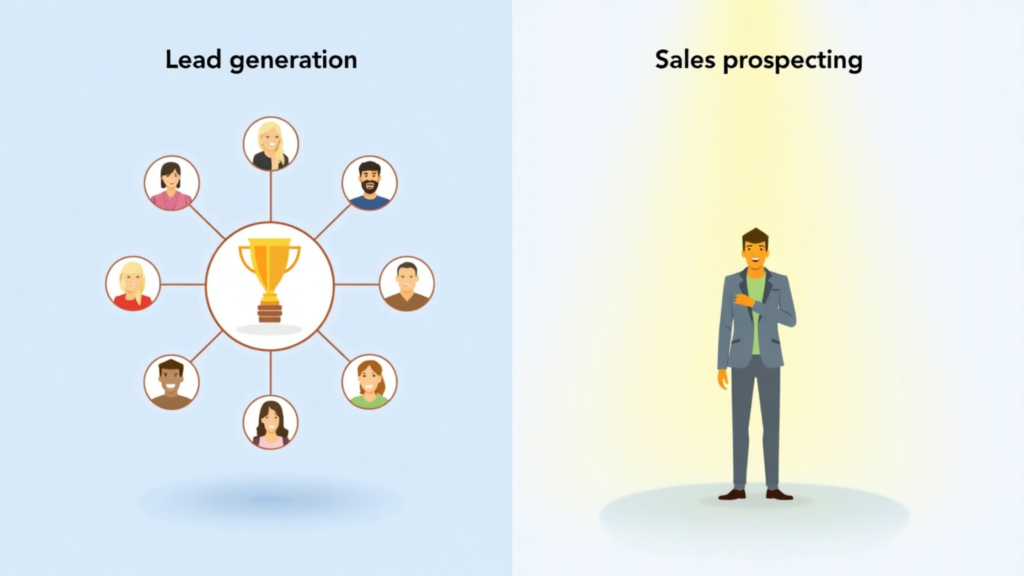Lead Generation vs Prospecting: A Complete Guide ( Updated – 2025 )

In the ever-evolving landscape of sales, the distinction between lead generation vs prospecting is more critical than ever. These foundational strategies determine how businesses attract potential clients and convert them into loyal customers.
This guide delves deeply into each method, providing you with essential insights to differentiate and effectively apply these strategies within your sales processes.
Understanding the Key Differences

While both lead generation and prospecting aim to enhance sales, their approaches, objectives, and impacts on the sales funnel are distinctly different.
- Goals and Objectives: Lead generation focuses on drawing potential customers through engaging content and offers, capturing their information for further nurturing. In contrast, prospecting is about actively searching for potential leads to assess their interest and fit for your products or services directly.
- Methods and Techniques: Lead generation leverages a mix of digital marketing strategies, including SEO, content marketing, and extensive social media campaigns to reach a broad audience. Prospecting typically involves more personalized strategies such as direct emails, phone calls, and networking events aimed at engaging identified potential leads.
- Timelines and Conversion Rates: The lead generation process might take longer, as it involves nurturing leads through various stages of the marketing funnel, often requiring multiple touchpoints. Prospecting can be quicker, focusing on converting a well-defined target audience into sales-ready leads more directly.
The Integration of Lead Generation and Prospecting

Combining lead generation and prospecting can significantly streamline and enhance the effectiveness of your sales strategy.
- Strategic Importance: The integration of both methods ensures a comprehensive approach to market coverage, enabling businesses to not only cast a wide net but also to engage deeply with the most promising prospects.
- Practical Example: An in-depth case study here could illustrate how a technology company effectively combined digital lead generation with direct prospecting to increase its sales pipeline and overall market share.
Step-by-Step Process Guide

Effectively executing both lead generation and prospecting requires a nuanced understanding of each method and the right tools.
Lead Generation in Practice:
- Content Marketing: Develop compelling content that addresses the needs and interests of your target audience, encouraging them to engage further with your brand.
- Digital Marketing: Enhance your online presence through targeted SEO practices and robust social media strategies that ensure your content reaches the right audience.
- Direct Engagement: Utilize email marketing and online ads to directly engage with leads, guiding them towards making a purchase.
- Essential Tools: Tools such as HubSpot for automation and Marketo for campaign management play critical roles in facilitating these activities.
Prospecting Techniques:
- Personalized Communication: Use targeted communication methods to connect directly with potential clients, from personalized emails to strategic phone calls.
- Building Relationships: Engage in networking and leverage referrals to expand your prospect base actively.
- Supporting Tools: Implement tools like LinkedIn Sales Navigator for targeted outreach and Cognism for data-driven prospecting.
Measuring Success and ROI

Evaluating the effectiveness of your lead generation and prospecting efforts is vital through key performance indicators.
- Lead Generation Metrics: Analyze metrics such as lead conversion rates, cost per lead, and the effectiveness of different traffic sources.
- Prospecting Metrics: Track the response rate, the number of appointments set, and the eventual conversion rates to assess the efficiency of your prospecting activities.
Common Challenges and Solutions

Address common obstacles in lead generation and prospecting with strategic solutions.
- Anticipated Challenges: Identify typical pitfalls such as targeting the wrong audience or poor alignment of marketing and sales efforts.
- Strategic Resolutions: Offer a troubleshooting guide that provides actionable steps to optimize processes and rectify common mistakes.
Emerging Trends in Sales Strategies

Stay ahead of the curve by adopting the latest innovations in sales technology and strategy.
- AI and Automation: Explore how emerging AI technologies like predictive analytics and automated engagement tools are revolutionizing lead qualification and customer interaction.
- Advanced Personalization: Delve into sophisticated personalization tactics that leverage analytics to tailor marketing efforts to individual prospects, enhancing engagement and conversion rates.
Conclusion
Repeat the importance of integrating lead generation and prospecting into your sales strategy to maximize effectiveness. Highlight how our services and tools are specially designed to tackle these challenges, inviting readers to explore further to enhance their sales outcomes in 2025.
This expanded guide aims to provide a thorough exploration of lead generation and prospecting, enriched with detailed explanations, practical applications, and insights into future trends, offering a valuable resource for sales professionals aiming to excel in their field.
Enhancing Your Sales Strategy with B2B Lead Generation Services
Discover how specialized B2B lead generation services can revitalize your sales strategy, ensuring a steady flow of high-quality leads tailored to your business needs.

- Tailored Lead Strategies: Saletancy provides Custom solutions that align with your unique market position and business goals.
- Expertise in Diverse Industries: Benefit from deep industry knowledge across various sectors to capture the most relevant leads.
- Advanced Technology Use: Leverage cutting-edge technology and tools to streamline the lead generation process.
- Comprehensive Service Suite: From initial research to final lead scoring and nurturing, get all the services you need in one place.
- Results-Driven Approach: Focus on strategies that directly enhance your ROI, with metrics to track success and make informed decisions.
For more in-depth information on how these services can benefit your business, contact us for B2B Lead Generation Services.
FAQs:
1. What is the difference between a prospect and a lead?
A lead is an individual or organization that has shown interest in your products or services, typically by sharing contact information. A prospect is a qualified lead who has been determined to fit the target market and has the potential to become a customer.
2. Which comes first, lead generation or prospecting?
Lead generation usually comes first in the sales process. It involves gathering leads through various marketing efforts. Prospecting follows, where these leads are then evaluated and contacted to determine their potential to convert into actual sales.
3. How to approach prospecting and lead generation?
Approaching prospecting and lead generation effectively involves a strategic plan:
- For lead generation, focus on attracting a wide audience through content marketing, SEO, and social media.
- For prospecting, use the information gathered during lead generation to personalize outreach and engage directly with potential clients.
4. What is the difference between lead generation and sales?
Lead generation is the process of attracting individuals or entities to your product or service and converting them into someone interested in your company. Sales is the process of converting these interested individuals or entities, now leads, into paying customers.
5. How can integrating lead generation and prospecting boost sales?
Integrating lead generation and prospecting can boost sales by creating a seamless transition from attracting potential customers to engaging them in a sales conversation. This alignment ensures that the marketing efforts support sales activities by providing high-quality leads that are more likely to convert.
6. What tools are essential for successful lead generation and prospecting in 2025?
For successful lead generation, tools like HubSpot and Marketo for automation and campaign management are vital. For prospecting, tools such as LinkedIn Sales Navigator and Cognism help in targeting and engaging potential clients efficiently.
7. How do I measure the success of lead generation and prospecting activities?
Success in lead generation can be measured by metrics such as conversion rates and cost per lead. For prospecting, key performance indicators include response rate, appointments booked, and conversion rate.
8. What are the latest trends in lead generation vs prospecting?
The latest trends include the use of AI and machine learning for predictive analytics, enhanced personalization through data-driven marketing, and increased use of automation tools to streamline both lead generation and prospecting processes.